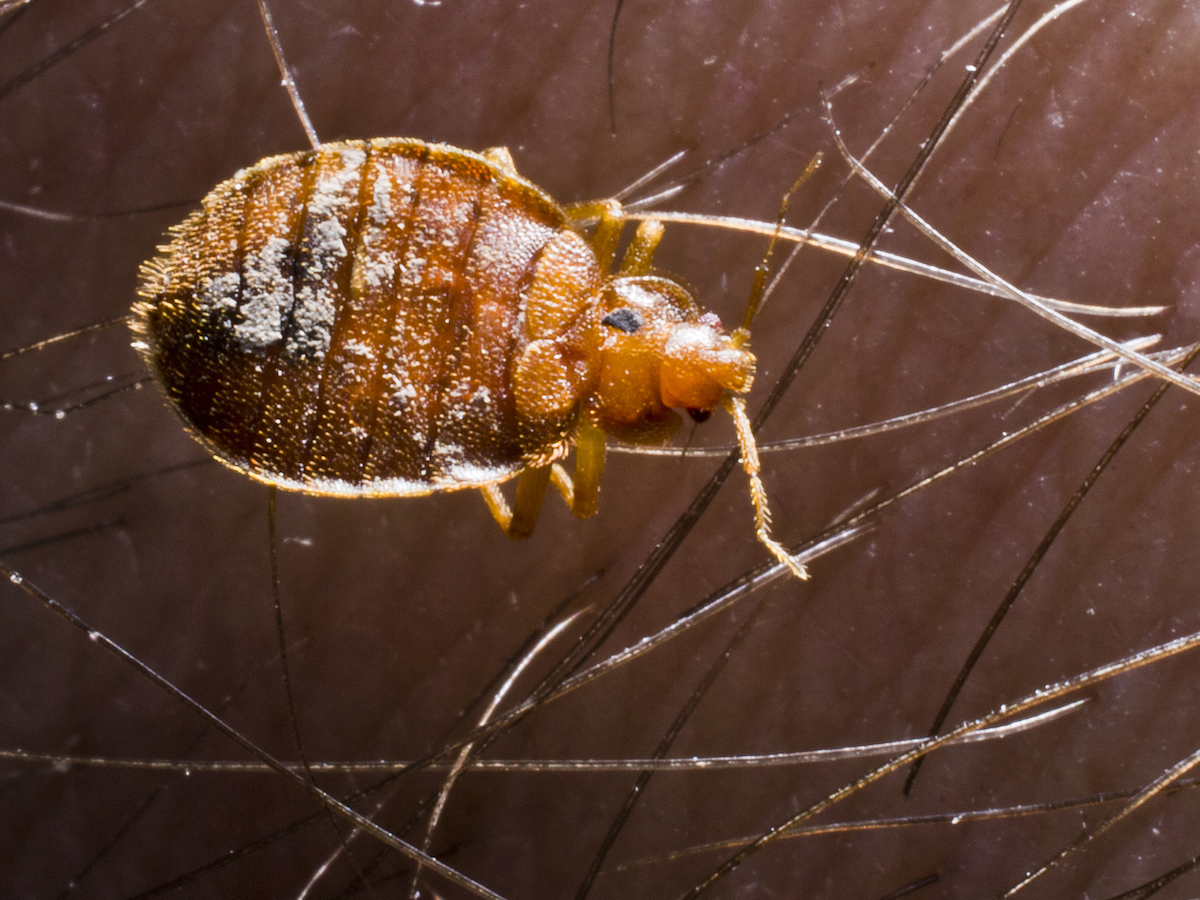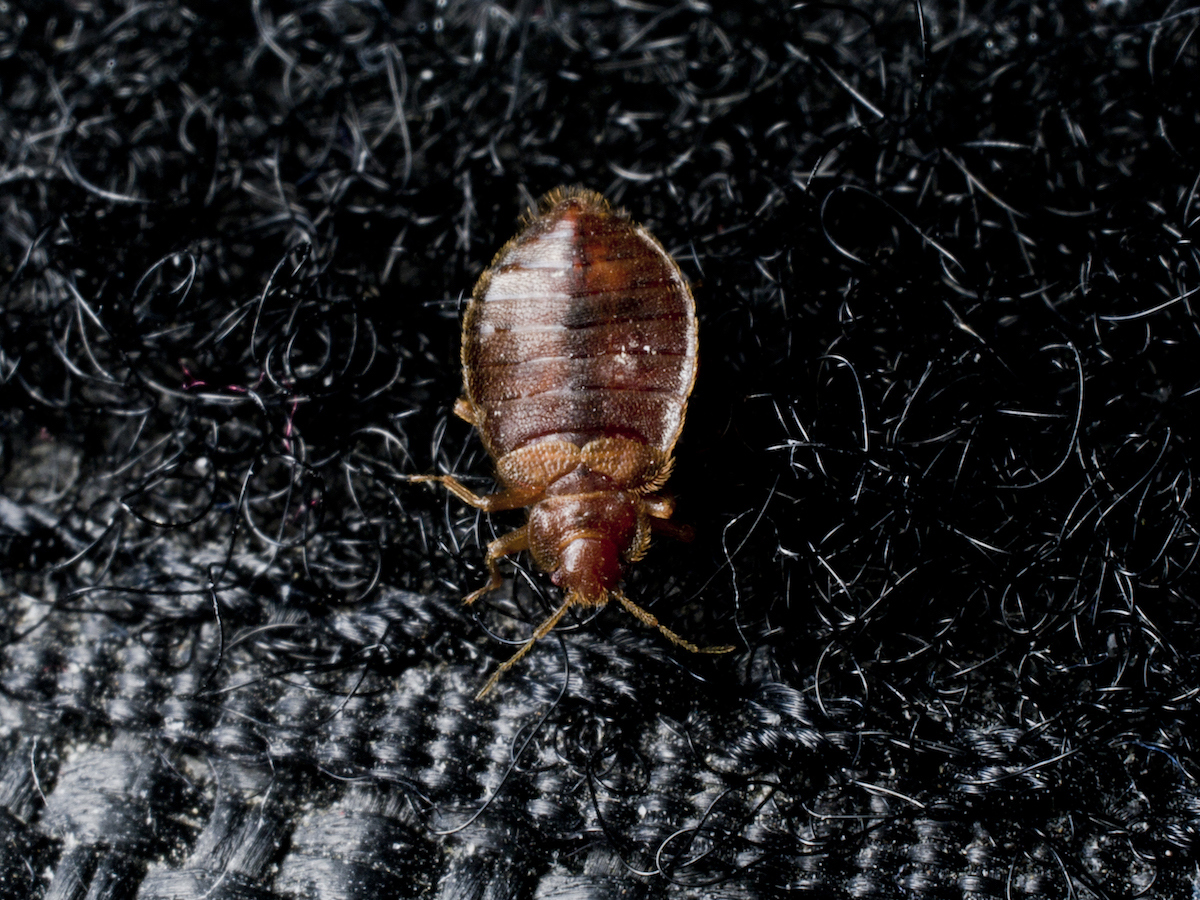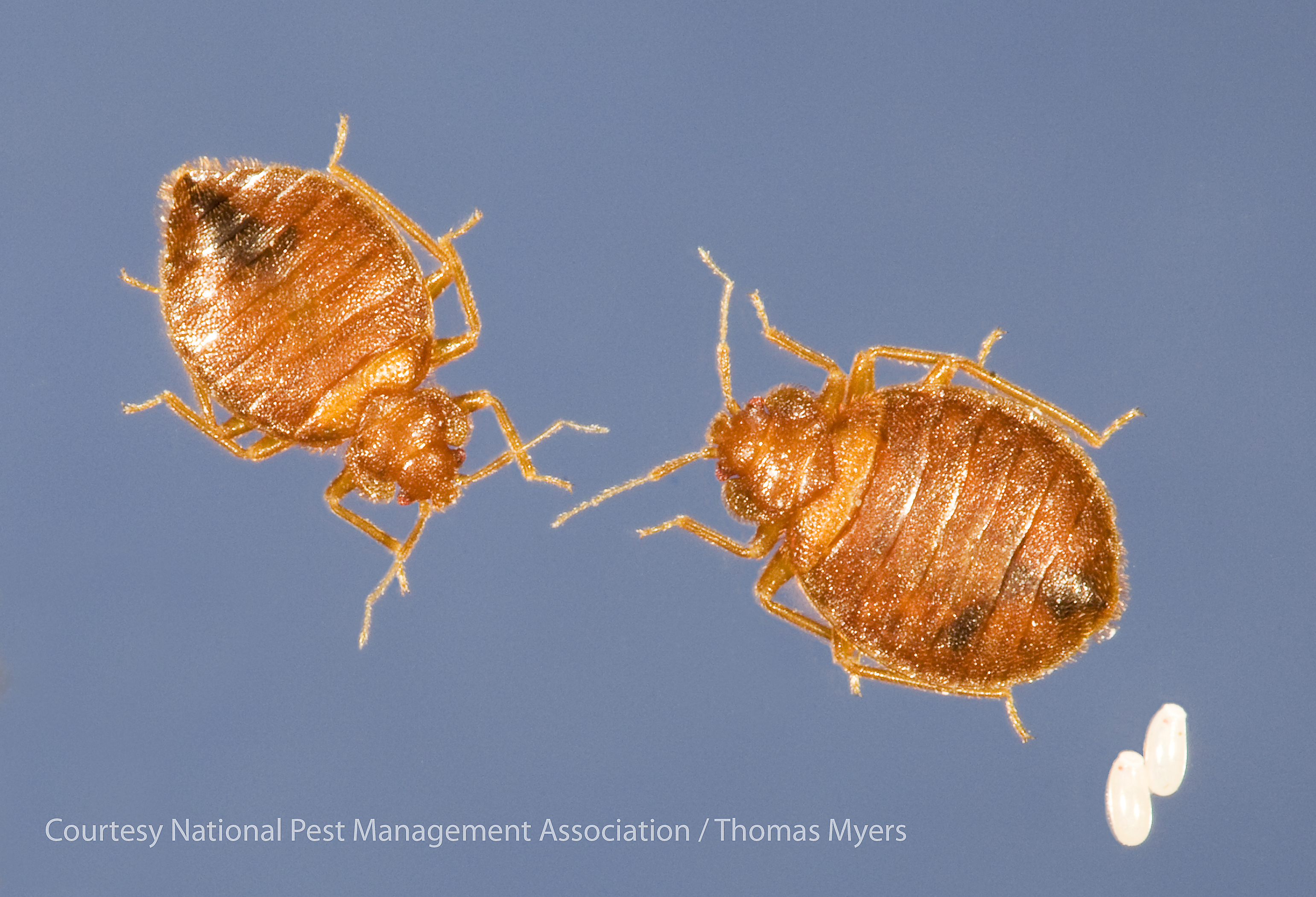Bed Bugs Cimex lectularius

Identify Bed Bugs
Color: Unfed adults are mahogany; engorged bed bugs are red-brown. Nymphs are nearly colorless.
Size: Adults are 1/4 inch long. Nymphs range from 1.3 mm to 4-5 mm.
Legs: 6
Antennae: Yes
Shape: Flat, broad oval when unfed; swollen and elongated when fed.
Region: Found throughout U.S.
What are Bed Bugs?
Bed bugs are small, brownish-red bugs famous for dwelling in beds and feeding on humans while they sleep. If you’re wondering where bed bugs come from, they have been associated with humans for more than 3,300 years and are found in virtually every place people tend to gather, including residences, hotels, schools, offices, retail stores and even public transportation. Bed bugs feed only on blood and must have regular blood meals to survive and develop. Humans are not bed bugs’ only targets, they also will attack many warm-blooded animals, including poultry and other birds.
Bed bugs are great “hitch hikers,” allowing them to travel long distances. They latch onto suitcases, clothes, and linens and can end up wherever these items are taken. This is why the spread of bed bugs occurs so easily. It’s often hard to identify bed bug bites, and they can easily be confused with bites from a different pest, making infestations difficult to detect and allowing populations to grow unnoticed. Knowing how bed bug infestations start and what a bed bug looks like is essential to avoiding an infestation. Read on for all the details, or view more photos and videos here.
What Does a Bed Bug Look Like?
Identifying bed bugs is essential to ensure you avoid carrying them with you. Bed bugs are an oval shape and only grow to about 3/16th of an inch in length. Prior to feeding, they are brown and flat. After feeding, bed bugs become more red in color, swollen, and elongated. Bed bugs have 6 legs and 2 antennae. Despite having reduced “wing pads,” bed bugs do not have wings and cannot fly.
Adult bed bugs are visible to the human eye and can be detected by sight, especially within mattress seams and box springs. Bed bug nymphs can be harder to identify, as they are smaller in size and paler in color.
Because bed bugs can be found in any location where humans congregate and spend extended time, it is important to be on the lookout for bed bugs when using public transportation or sitting in public spaces like libraries. In particular, hotel rooms should be thoroughly inspected before sleeping in the bed. Here are some tips to identify where bed bugs come from:
- Check the bedsheets for tell-tale blood spots or sightings of the bugs or eggshells
- Use a small flashlight to assist with visual inspections
- Because bed bugs also tend to travel easily, be sure to vacuum suitcases and inspect for any signs of bed bugs upon returning from a vacation
- Also consider bringing a large trash bag to keep your suitcase in during hotel stays and wash clothes on hot cycles once you return home, even those that haven’t been worn
Additionally, never bring second-hand furniture, especially mattresses and box springs, into a home without thoroughly examining for signs of bed bugs. You might consider having a pest control professional inspect the furniture as it is difficult to detect an infestation if you are untrained.
So, where do bed bugs come from? Bed bugs are excellent at traveling well hidden. They will latch onto suitcases, boxes, shoes and other items and travel on the objects to a new home. How do bed bug infestations start? Once introduced into a new environment, they will spread throughout their new surroundings, whether it be a large building or a single-family home.
Bed bugs can take up residence in many places besides just a bed, such as the cracks and crevices in walls or wood. They also like to hide behind baseboards, around mattress buttons, within bedding and inside box springs. In some instances, bed bugs can come from inside electrical switch plates, picture frames, and wallpaper. These elusive pests can be found nearly anywhere inside a home, car, bus, or other shelter. In hotels, the most common place to find bed bugs is within the backside of headboards that are mounted on walls.
Research from the National Pest Management Association uncovered that bed bugs can be found just about anywhere. The three most common structures bed bugs were discovered were:
- Single-family homes (91 percent)
- Apartments/condominiums (89 percent)
- Hotels/motels (68 percent)
However, they were also found in places one might not expect, including:
- Nursing homes (59 percent)
- Schools and daycare centers (47 percent)
- Office buildings (46 percent), college dorms (45 percent)
- Hospitals (36 percent)
- Public transportation (19 percent)
It is important to understand what a bed bug looks like and know how to identify the tell-tale signs of bed bugs whenever spending time in a populated area.
Bed bugs usually come out at night to eat. However, they are opportunistic feeders and will take a blood meal during the day, especially in heavily-infested areas.
Bed bugs usually require 5-10 minutes to engorge with blood. After feeding, they move to secluded places and congregate for several days until they are ready to feed again. During this time in the bed bug life cycle, they digest their meal, mate and lay eggs. It is possible for adult bed bugs to go several months without a blood meal. They also can withstand temperatures from nearly freezing up to 122 degrees Fahrenheit, allowing them to survive in harsh conditions.
Although bed bugs can dine on many warm-blooded animals, they primarily feed on humans. Because their bites are nearly painless, humans usually don’t notice or wake up when bitten. Bed bugs do not transmit disease, but their bites can cause red, itchy welts. These bites do not need professional treatment, and people who experience severe itching usually can find relief with topical steroid creams.
Perhaps the most alarming feature of bed bugs is their fast-reproductive nature. Females lay 1-5 eggs per day, reaching up to 541 eggs in their lifetime. It only takes about 21 days for these nymphs to become adult bed bugs. Once bed bugs start, they can quickly infest an entire household or building. Once established, an infestation can be extremely difficult to get rid of. This is why it is so important to contact an exterminator as soon as a bed bug infestation is identified.
Humans are the preferred host for bed bugs, and they will latch onto skin that is exposed while the host is sleeping. Although the bite is painless at the time of the attack, most people develop an allergic reaction to the saliva that is transmitted during the bite. This is what causes bites to become red, itchy and swollen. Bites tend to be found in a pattern or in small clusters. This can be an indication that the bites are from bed bugs and not a different pest.
However, some humans never have a reaction to bites, making a bed bug infestation hard to identify. After times of extended exposure, it is possible for humans to reach a point where they no longer have a reaction or their reaction may become more severe.
How do bed bugs start an infestation in your home? They can travel on clothes, on linens, in luggage, and more. If bed bugs are passed onto something like bed sheets and are not immediately taken care of, they will continue to spread.
Bed bugs are most easily identified by small reddish-brown fecal spots on mattresses, upholstery or walls. If these spots are found, it can indicate an infestation. Bites on the arms and legs are also a tell-tale sign of bed bugs. While these bites can be small, if they swell and become itchy, they are noticeable. It can take two to three days for these bites to appear, allowing the infestation to grow. However, bites alone do not indicate an infestation without other bed bug evidence.
Infestations can also be identified by sightings of bed bug molt skins, their eggs, empty eggshells, or the bugs themselves. All of these things are quite small, but still visible to the human eye. Bed bug molt skins as well as their eggshells appear pale white after molting or emerging from the eggshell, respectively.
Bed bugs are extremely elusive creatures, so professional help should be sought when dealing with an infestation. You should not try to treat them on your own. I According to an NPMA survey, 76 percent of pest professionals say they are the hardest bug to eradicate. If you suspect or discover an infestation, contact a licensed professional immediately.
You can also find additional, specific bed bug prevention tips here:
- How to Prevent Bed Bugs
- Bed Bug Prevention Tips for College Students
- Bed Bug Prevention Tips for Schools
- Bed Bug Prevention Tips at Summer Camp
- Bed Bug Prevention Tips for the Office
- Bed Bug Prevention Tips While Shopping
- Commercial Protocols for Bed Bugs
- Bed Bug Public Policy and Laws
- Bed Bug Laws by State







